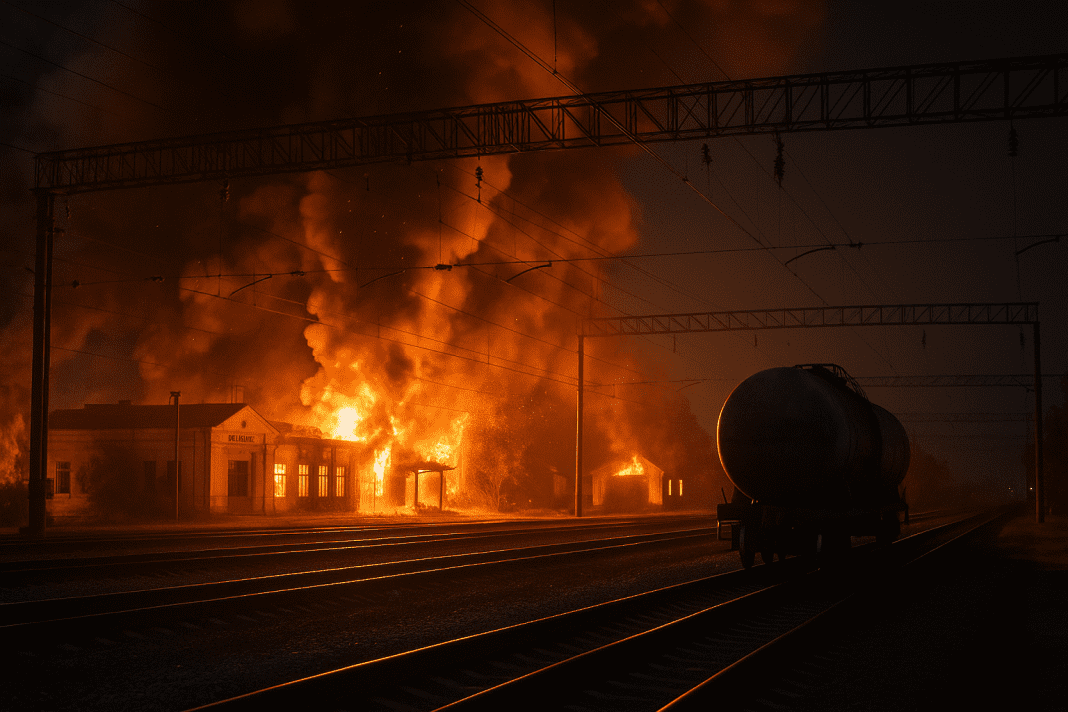On the night of August 5, Ukrainian drones carried out a large-scale attack targeting the Tatsinskaya railway station in Russia’s Rostov Oblast, according to local media reports. Authorities regard this railway station as a key point for transporting oil products and grain and consider it the region’s strategic logistical hub because of its significance.
Ukrainian Drones Strike Vital Railway Hub in Rostov Oblast
The Tatsinskaya station is within striking range of long-distance drones, and it is only 100 kilometers from the Ukrainian border and about 305 kilometers from Ukrainian-held Pokrovsk in Donetsk Oblast. During the night, Russian air defenses tried to intercept the inbound drones, resulting in at least ten explosions reported throughout Rostov Oblast.
Local residents reported loud blasts, with some hearing multiple rounds of anti-aircraft fire. The exact number of drones involved is not yet confirmed. However, the scale of the explosions suggests a coordinated and widespread attack.
🔥 Russia’s war machine takes a hit as Ukrainian drones strike Nevinnomyssk chemical facility
While Ukraine’s military has not officially commented, these strikes align with Ukraine’s recent pattern of targeting Russian military infrastructure far from the front lines. Such attacks aim to disrupt supply chains, oil operations, and transport logistics inside Russian territory.
Power Outages and Fires Follow Drone Attack in Rostov
The drone strikes caused damage and disruptions in several districts of Rostov Oblast, including Bely Kalitva, Tatsinsky, Chertkovsky, and Millerovsky. In the Millerovo area, drone strikes caused electricity blackouts. The Donenergo utility company confirmed that the damage from the drone activity partially shut down mobile networks, leading to temporary communication problems in the affected areas.
In Verkhnetalovka, located in the Millerovsky region, a substation at a farmstead caught fire. Emergency crews quickly extinguished the blaze. Another fire broke out near the Tatsinskaya railway station, where flames burned a canopy in a private home’s yard. Rostov Oblast acting Governor Yuriy Slyusar stated that officials brought the fires under control quickly.
Ukrainian Drones Destroy Russian Military Satellite Equipment in Bold Kursk Attack
Although the attack caused significant disruption, emergency services reported no injuries. Authorities have not yet revealed the full extent of the infrastructure damage, but the power and communication disruptions show that the drone strikes caused broader effects than just isolated fires.
The Rostov region has previously seen cross-border tensions, but this latest strike is among the most severe and coordinated in recent months. Given the region’s importance as a transport and energy hub, drone attacks here can significantly impact logistics and daily life.
Broader Pattern of Drone Strikes Inside Russia
This attack on Rostov Oblast comes as part of a larger wave of drone strikes by Ukraine. The Security Service (SBU) of Ukraine launched drones against a military airstrip in Saky, in Russian-occupied Crimea, on the evening of August 4. A Su-30SM fighter plane was destroyed, another was damaged, and three Su-24 bombers and an aviation weapons storage facility were attacked during the operation.
In Russia’s Volgograd Oblast, the Archeda train station was also the target of another significant drone strike. This attack disrupted rail movement and temporarily shut down a nearby regional airport. Though separate from the Rostov incident, the timing and targets show a widening campaign by Ukraine to challenge Russian control over logistics routes.
Ukraine’s military also reported the destruction of a Russian S-300 surface-to-air missile system in Zaporizhzhia Oblast, an area currently under Russian occupation. These strikes indicate an increased use of unmanned aerial vehicles (UAVs) for deep attacks on critical infrastructure.
🔥 Zelenograd on fire: 93 Ukrainian drones hit residential area, flights diverted from Moscow
Meanwhile, the consequences of repeated strikes on oil-related sites are being felt economically. Russian gasoline prices, especially for Ai-95 fuel, have reached record highs on the St. Petersburg International Mercantile Exchange (SPIMEX). Analysts link these rising costs directly to recent attacks, including those on facilities in Rostov and around Moscow.
The drone strike on Rostov Oblast, especially the Tatsinskaya railway station, has drawn attention to Ukraine’s growing reach and the vulnerabilities of infrastructure deep inside Russia. The fires, power outages, and communication disruptions serve as a reminder of how modern warfare has evolved, where drones can deliver damage far from the front lines without putting soldiers at direct risk.
